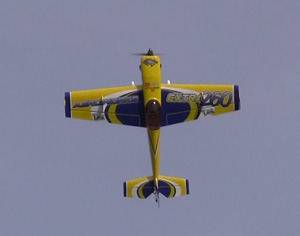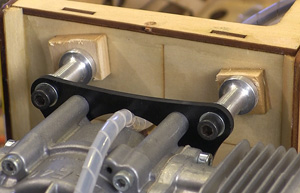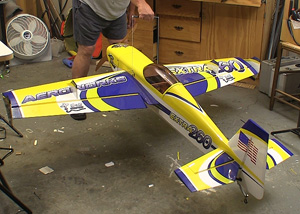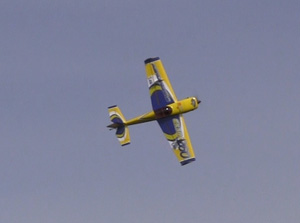


Text, photos and video by Tom Hintz
Flight video by Clark Ponthier
Posted – 9-30-2014

When my 26% YAK did a world class dead stick/elevator/belly flop much of the air frame and the mufflers were DOA. However, the engine and radio gear escaped damage. Because of my recent success with the Aeroworks 60cc Freestyle Extra 260 QB-L I went back to Aeroworks for an airframe to carry around my DLE-40 Twin. Settling on the Aeroworks 30cc Freestyle Extra 260 QB-L, a little brother to the Aeroworks 60cc Freestyle Extra 260 QB-L was pretty much a no-brainer.
The Aeroworks 30cc Freestyle Extra 260 QB-L as a wing span of 76”and is 69”-long overall. Designed to finish out at 10-1/2 to 11-pounds flying on 1175 sq. in. of wing area should add up to a great mid to slow-speed plane. The cowl is 8-1/2”-wide which is very close to fitting my DLE-40 Twin without major carving. I still anticipate having at least the plugs and wires hanging out but the cowl needs some openings to let air out for more efficient with cooling. The air frame also has a rather large air dump built into the bottom at the rear of the cowl.
The Aeroworks 30cc Freestyle Extra 260 QB-L is designed for 30 to 35cc gas engines but I found several people with 40-twin engines in this plane on forums and all like the combination. The DLE-40 Twin is slightly less powerful than its 35cc kin but that does not seem to be an issue. We will see.
The Aeroworks 30cc Freestyle Extra 260 QB-L comes with carbon fiber main gear and a nice single leaf steerable tail wheel assembly. A fuel tank is included but I opted for the Fortitude 16-oz with a three line system. I did use the fuel filler and vent dots that came with the kit.
The side force generators that give this plane distinctive looks and performance are included. The outer and mid-wing SFG’s are removable to make transporting the wings easier. The cowl is pre-installed and uses 6 fasteners with rubber grips to hold it firmly. The bottom of the fuselage just behind the cowl has a large air dump that goes a long way towards keeping the engine cool. The canopy is secured with a single spring latch rather than screws. The canopy frame also has two hook-like indexers that help secure the forward portion of the canopy.

Assembly of the Aeroworks 30cc Freestyle Extra 260 QB-L went nicely and faster than I anticipated, even with the constant starting and stopping to set up photo and video shots. I quickly had all of the supplied carbon control horns epoxied into the surfaces and the servos mounted. The included control linkages consist of titanium turnbuckles screwed into 4/40 ball links on both ends. These assemblies are very stout and extremely easy to adjust perfectly because nothing has to be taken apart to do it. If you don’t get your control surfaces perfectly zeroed at neutral trim you can count on it being your fault.
I used a tubular carbon fiber pushrod for the throttle and discovered that with the throttle arm on the DLE 40-twin turned around so that the linkage pulls to go faster the control rod was at the same height as the floor of the motor box. A little bending of the titanium end at the throttle raised the rod height above the floor of the motor box; problem solved.
With the tail feathers installed I bound the AR8000 Spektrum receiver and zeroed the rudder and elevator halves. I always set up my favorite “all I can get” throws initially and found that I could not fully deflect the elevators with the 1-1/4” servo arms the instructions specify. While I am sure that the Aeroworks 30cc Freestyle Extra 260 QB-L would be impressively aerobatic that way I found a set of 1-1/2” servo arms, put them on and could move the elevators through their full range of available motion. I actually had to take a few points off of the elevator servo travels to eliminate a slight bind when the elevators ran up against the stabs. Later I will dial in the suggested throws in two dual rate settings.
While waiting for new DLE 40-twin mufflers I decided to install the B & E Graphix. I bought one of their packages designed for the Aeroworks 30cc Freestyle Extra 260 QB-L and added a pair of flags for the vertical stabilizer, DLE Engines stickers and a “torn” graphic for the top of the cowl. As always, the B&E Graphix went on easily and look great.
I also took this opportunity to go over all of the covering and graphics edges with a sealing pen that I purchased from B&E Graphix when ordering the stickers. Sealing the edges of the covering and stickers helps reduce the chances of fuel and oil loosening them. This doesn’t make the covering bulletproof but it helps.

.Next up was cutting the cowl to accommodate the DLE 40-twin spark plugs and wires that exceed the cowl width. I also needed to make openings for the down tubes from the mufflers and for the choke rod that I made from a piece of 2/56 rod with a plastic clevis. One more hole was needed for access to the carb adjusting screws. I am a firm believer in lots of air getting out as well as into the cowl so added a series of slots under the nose using a template saved from my Aeroworks 60cc Freestyle Extra 260 QB-L build.
The last shop task was setting the CG using the very cool CG Buddy Aeroworks includes in the kit. If you have not seen this little gem you need to. Checking the CG on a plane this big is tough to do accurately but the CG Buddy literally makes this a one-handed job.
A pair of wooden and plastic fittings are placed between the wings and fuse, locking over the carbon fiber tube and the forward locating pin. Then you loop the ends of the cord around the retainers on those fittings and lift the plane off the ground with the handle. It really is that easy but more importantly it is dead on accurate. Move things around until the plane hangs level and you have the CG perfect. I like my planes to be a tad tail heavy but with the CG Buddy I can start out almost on the CG point, with the tail just a little down. Then if I want to sharpen the handling response more I can move the CG back a little bit at a time until I get the handling I want. When you see how simple the CG Buddy is you will be wondering why all plane manufacturers aren’t doing this. Of course now that Aeroworks did it, they have to try and make something that doesn’t look like they copied Aeroworks. Good luck with that!
The maiden flight went remarkably well. The Aeroworks 30cc Freestyle Extra 260 QB-L lifted off easily and needed just a couple clicks of left aileron and later one click of down to establish a nice float back to the ground on landing.

During the second flight I forgot to increase my idle trim a few clicks and during a pop up the engine quit and I got to do my first dead stick and minor stress test with this plane. I couldn’t make it back to the runway so opted for some tall grass. Unfortunately just out of sight was the end of the tall grass and the beginning of way shorter wild weeds. The Aeroworks 30cc Freestyle Extra 260 QB-L did flip over when the wheels snagged the weeds but the only damage was a cracked elevator half that apparently caught on a tough weed as it settled in. The landing gear, their mounts and even the prop survived so back to the shop and I had the Aeroworks 30cc Freestyle Extra 260 QB-L ready to fly or the first day of video shoots the next morning. My bad but it did show that the Aeroworks 30cc Freestyle Extra 260 QB-L is tough and showed me that it glides way farther than I expected. Also, I had one more deadstick on day two and you can see that one happen in the video.
I normally fly all of my planes on my “wide open” (all I can get) control surface throws and the Aeroworks 30cc Freestyle Extra 260 QB-L felt very responsive yet easily controllable. I would discover later that you can over do the rudder on this plane in some situations. I did set the medium and low rates as prescribed in the manual but I like the full-on throws better. I do suggest if this type of hyper active capable plane is new to you, start on the medium or low rates. The Aeroworks 30cc Freestyle Extra 260 QB-L is capable of wild tumbles and virtually any aerobatic maneuver you can think of so you might want to feel it out on the lower rates a bit at first.
The DLE-40 twin swinging a Vess 20B prop proved to generate all of the energy the Aeroworks 30cc Freestyle Extra 260 QB-L needs to fly, tumble and do other spectacular things in the air. I never felt lacking for power, even in a full hover and having to bail out. Go to full power and it pulls itself out of whatever position I had it in with full response from the huge ailerons, elevator and rudder.
Flying the Aeroworks 30cc Freestyle Extra 260 QB-L is a pure joy. All of the controls respond well, even at surprisingly low speeds. This plane will fly very straight or tumble with the best of them. The first time I did a knife edge spin with this plane it got the attention of nearly everyone else at the field. It really gets cranking if you stay with it a little. The other good news is that the Aeroworks 30cc Freestyle Extra 260 QB-L pulls out of these maneuvers quickly and with good control.
The only time I felt surprised by the Aeroworks 30cc Freestyle Extra 260 QB-L handling was when I did a tight turn and kicked too much rudder in. This plane responds to rudder input with authority and you can give it too much. When I kicked in the rudder during that tight turn the tail on the Aeroworks 30cc Freestyle Extra 260 QB-L jumped up and the plane was now trying to fly almost totally sideways, nose down maybe 20 feet up. I released the rudder and it came right back but I was breathing a little harder. I am used to hammering the rudder around but on the Aeroworks 30cc Freestyle Extra 260 QB-L (and Aeroworks 60cc Freestyle Extra 260 QB-L) you need to respect this control. I took the rudder expo up to 70% and would later reduce the throw by around 5-degrees. That change along with me paying more attention to how I use the rudder did the trick.
The rudder is so effective when combined with the included side force generators that knife edge flight requires surprisingly little input. When you give the Aeroworks 30cc Freestyle Extra 260 QB-L the just amount of rudder it needs to stay away from the ground there is no coupling. While investigating various rudder inputs I found that you can induce coupling on this plane by adding considerably more rudder input than is necessary.
The good news is that the rudder along with everything else about the Aeroworks 30cc Freestyle Extra 260 QB-L is very easy to get used to. It is very predictable and handles slow speed flight exceptionally well. The second day of flying the Aeroworks 30cc Freestyle Extra 260 QB-L was done in 20-mph gusts and it handled that wind very well. Even landings were very easy as the plane approached the ground.

The Aeroworks 30cc Freestyle Extra 260 QB-L is a great airplane that is surprisingly easy to fly. This plane is so steady, predictable and stable I would have no fear of teaching a new pilot on it using a buddy box. I like teaching people on a plane that as capabilities they can enjoy after mastering the basics and the Aeroworks 30cc Freestyle Extra 260 QB-L has that covered and then some. On lower rates this plane flies as easily and as stable as any trainer but with more capabilities available later. As the student progresses the throws can be increased to keep up with their skills. The Aeroworks 30cc Freestyle Extra 260 QB-L can replace two or three of the trainer and intermediate planes we used to recommend to a new pilot as they honed their basic skills and wanted to do more aerobatics as we all do.
The Aeroworks 30cc Freestyle Extra 260 QB-L has a street price of $549.95 (9-29-2014) which is not bad at all considering the quality of the plane itself and the hardware you get with it. This plane flies very well with a 35cc engine which is economical and probably the most popular size which gives you lots of options should you ever want to put the flight gear in another plane. However, I think that most people will leave the engine in the Aeroworks 30cc Freestyle Extra 260 QB-L and keep flying it for a very long time. You can get other styles of planes but you are not going to find an all-around plane that performs better or is easier to fly than the Aeroworks 30cc Freestyle Extra 260 QB-L.
To visit the Aeroworks 30cc Freestyle Extra 260 QB-L web page Click Here
Have a comment on this review? –Email Me!